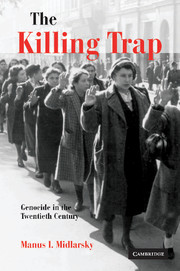Book contents
- Frontmatter
- Contents
- Preface
- PART I Introduction
- PART II Explaining perpetrators: theoretical foundations
- PART III The theory applied
- PART IV Victim vulnerability: explaining magnitude and manner of dying
- 10 Raison d'état, raison d'église
- 11 Cynical realpolitik and the unwanted
- 12 High victimization: the role of realpolitik
- 13 Inequality and absence of identification
- 14 On the possibility of revolt and altruistic punishment
- PART V Exceptions
- PART VI Conclusion
- References
- Index
10 - Raison d'état, raison d'église
Published online by Cambridge University Press: 22 September 2009
- Frontmatter
- Contents
- Preface
- PART I Introduction
- PART II Explaining perpetrators: theoretical foundations
- PART III The theory applied
- PART IV Victim vulnerability: explaining magnitude and manner of dying
- 10 Raison d'état, raison d'église
- 11 Cynical realpolitik and the unwanted
- 12 High victimization: the role of realpolitik
- 13 Inequality and absence of identification
- 14 On the possibility of revolt and altruistic punishment
- PART V Exceptions
- PART VI Conclusion
- References
- Index
Summary
The etiologies of the onset and magnitude of genocide are not necessarily distinct processes. Variables like realpolitik and the contraction of socioeconomic space associated with loss can influence both facets of genocide. But in this part of the book, emphasizing the magnitude of the killing, we are not dealing with temporally based processes, as in the transformation of massacre to genocide detailed in figure 5.1. The onset of genocide is not a dichotomous variable; it has strong elements of continuous build-up over time until the decision to commit genocide is reached. The magnitude of the killing, on the other hand, can be influenced simultaneously by several factors, each of them acting for the most part independently of others.
To understand the magnitude of the killing, once again we begin with variables derived from the international context, namely realpolitik in two forms, cynical and brute force. Here, decisions by political elites in countries external to the killing sites can be critical in explaining magnitude. At the same time, as in altruistic punishment within the German military and society, we will turn to the societal context to understand behavior within besieged Jewish communities. Later chapters in this part will focus not only on altruistic punishment within East European ghettos, but also on inequality yielded by the contraction process and consequent failures of mutual identification that inflated the magnitude of the killing.
- Type
- Chapter
- Information
- The Killing TrapGenocide in the Twentieth Century, pp. 211 - 236Publisher: Cambridge University PressPrint publication year: 2005



